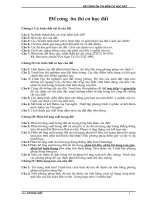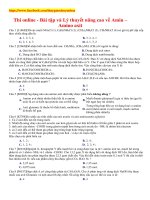bài tập và lý thuyết Halogens
Bạn đang xem bản rút gọn của tài liệu. Xem và tải ngay bản đầy đủ của tài liệu tại đây (3.27 MB, 248 trang )
41
41.1
41.2
41.3
The Halogens
Characteristic Properties of the Halogens
Variation in Properties of the Halogens
Comparative Study of the Reactions of
Halide Ions
41.4 Acidic Properties of Hydrogen Halides and
the Anomalous Behaviour of Hydrogen
Fluoride
41.1
Characteristic
Properties of the
Halogens
41.1 Characteristic Properties of the Halogens (SB p.78)
Introduction
•
Group VIIA elements include
fluorine
chlorine
bromine
iodine
astatine
41.1 Characteristic Properties of the Halogens (SB p.78)
Introduction
•
Astatine
not much is known
radioactive
41.1 Characteristic Properties of the Halogens (SB p.78)
Introduction
•
Group VIIA elements
also called halogens
41.1 Characteristic Properties of the Halogens (SB p.78)
The halogens
41.1 Characteristic Properties of the Halogens (SB p.79)
Introduction
•
All halogens
outermost shell electronic
configuration of ns2np5
one electron short of the octet
electronic configuration
41.1 Characteristic Properties of the Halogens (SB p.79)
Introduction
•
In the free elemental state
form diatomic molecules
complete their octets by sharing their
single unpaired p electrons
41.1 Characteristic Properties of the Halogens (SB p.79)
Introduction
•
When halogens react with other elements
complete their octets
depending on the electronegativity of
the element
41.1 Characteristic Properties of the Halogens (SB p.79)
Introduction
•
Either
gaining an additional electron to form
halide ions
or sharing their single unpaired p
electrons to form single covalent
bonds
41.1 Characteristic Properties of the Halogens (SB p.79)
chlorine
Appearances of halogens at room
temperature and pressure: chlorine
41.1 Characteristic Properties of the Halogens (SB p.79)
bromine
Appearances of halogens at room
temperature and pressure: bromine
41.1 Characteristic Properties of the Halogens (SB p.79)
iodine
Appearances of halogens at room
temperature and pressure: iodine
41.1 Characteristic Properties of the Halogens (SB p.79)
High Electronegativity
Electronegativity is the relative tendency
of an atom to attract bonding electrons
towards itself in a covalent bond.
41.1 Characteristic Properties of the Halogens (SB p.79)
High Electronegativity
•
All halogens
high electronegativity values
high tendency to attract an additional
electron to achieve the stable octet
electronic configuration
highest among the elements in the
same period
41.1 Characteristic Properties of the Halogens (SB p.79)
Electronegativity values of halogens
Halogen
Electronegativity value
F
4.0
Cl
3.0
Br
2.8
I
2.5
At
2.2
41.1 Characteristic Properties of the Halogens (SB p.79)
High Electron Affinity
Electron affinity is the enthalpy change
when one mole of electrons is added to
one mole of atoms or ions in the gaseous
state.
41.1 Characteristic Properties of the Halogens (SB p.79)
High Electron Affinity
•
Its value
indicates the ease of formation of
anions
41.1 Characteristic Properties of the Halogens (SB p.79)
High Electron Affinity
•
All halogens
negative values of electron affinity
high tendency to attract an additional
electron to form the respective halide
ions
41.1 Characteristic Properties of the Halogens (SB p.79)
Electron affinities of halogens
Halogen
Electron affinity (kJ mol–1)
F
–348
Cl
–364
Br
–342
I
–314
At
–285
41.1 Characteristic Properties of the Halogens (SB p.80)
Bonding and Oxidation State
•
Halogens
gain an additional electron to form
the halide ions
combine with metals to form metal
halides
held together by ionic bonding
41.1 Characteristic Properties of the Halogens (SB p.80)
Bonding and Oxidation State
•
The oxidation states of the halogens = –1
41.1 Characteristic Properties of the Halogens (SB p.80)
Bonding and Oxidation State
•
The halogen atoms
share their unpaired p electrons with
a non-metallic atom
form a covalent bond
41.1 Characteristic Properties of the Halogens (SB p.80)
Bonding and Oxidation State
•
Halogens (except fluorine)
exhibit an oxidation state of –1 or +1
in the covalent molecules formed
depend on the electronegativity of
the
elements that are covalently
bonded
with the halogens
41.1 Characteristic Properties of the Halogens (SB p.80)
Bonding and Oxidation State
•
All halogens (except fluorine)
can expand their octets of electrons
by utilizing the vacant, low-lying d
orbitals









